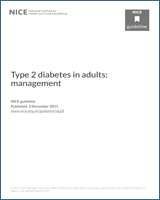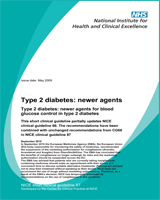All rights reserved. This material may be freely reproduced for educational and not-for-profit purposes. No reproduction by or for commercial organisations, or for commercial purposes, is allowed without the express written permission of NICE.
NCBI Bookshelf. A service of the National Library of Medicine, National Institutes of Health.
This publication is provided for historical reference only and the information may be out of date.
This guideline covers newer agents for blood glucose control in adults with type 2 diabetes; it does not address care for pregnant women with diabetes. It is a partial update of ‘Type 2 diabetes’, NICE clinical guideline 66 (CG 66), published in 2008, which updated NICE clinical guidelines E, F, G and H (2002) and updated and replaced the recommendations on type 2 diabetes in NICE technology appraisal guidance 53 (2002), 60 and 63 (2003).
Specifically, this guideline updates and replaces recommendations in sections 1.6, 1.7.1.3, 1.7.2 and 1.7.3 of CG66. The new recommendations from this short guideline use the same levels of HbA1c for the addition of extra glucose-lowering drugs as defined in CG 66 (that is, a value of 6.5% for people on one glucose-lowering drug and 7.5% for people on two or more oral glucose-lowering drugs or people needing insulin). The use of these different levels takes into account the increasing risk of hypoglycaemia with insulin and the clinical and cost-effectiveness of the newer agents. Otherwise, CG 66 stands.
This short guideline addresses the licensed indications of drugs as of September 2008. The recommendations do not apply to drugs not yet available in the UK and exclude liraglutide which did not receive UK marketing authorisation for type 2 diabetes during the development of this guideline. Recommendations are consistent with safety information from the European Medicines Agency and the Medicines and Healthcare products Regulatory Agency.
Contents
- July 2011 Update: MHRA advice on pioglitazone
- September 2010 Update: The European Medicines Agency (EMA) and rosiglitazone
- Foreword
- Patient-centred care
- 1. Summary
- 2. Evidence review and recommendations
- 2.1 Newer agents for blood glucose control
- 2.2 DPP-4 inhibitors (sitagliptin, vildagliptin)
- 2.3 Thiazolidinediones (pioglitazone, rosiglitazone)
- 2.4 GLP-1 mimetic (exenatide)
- 2.5 Long-acting human insulin analogues
- 2.6 Cost effectiveness
- 2.7 Interpreting the evidence to make recommendations
- 2.8 Research recommendations
- 3. References, glossary and abbreviations
- 4. Methods
- 5. Contributors
- 6. Appendices
This short clinical guideline partially updates NICE clinical guideline 66. The recommendations have been combined with unchanged recommendations from CG66 in NICE clinical guideline 87
NICE clinical guidelines are recommendations about the treatment and care of people with specific diseases and conditions in the NHS in England and Wales.
This guidance represents the view of NICE, which was arrived at after careful consideration of the evidence available. Healthcare professionals are expected to take it fully into account when exercising their clinical judgement. However, the guidance does not override the individual responsibility of healthcare professionals to make decisions appropriate to the circumstances of the individual patient, in consultation with the patient and/or guardian or carer, and informed by the summary of product characteristics of any drugs they are considering.
Implementation of this guidance is the responsibility of local commissioners and/or providers. Commissioners and providers are reminded that it is their responsibility to implement the guidance, in their local context, in light of their duties to avoid unlawful discrimination and to have regard to promoting equality of opportunity. Nothing in this guidance should be interpreted in a way that would be inconsistent with compliance with those duties.
- Type 2 DiabetesType 2 Diabetes
Your browsing activity is empty.
Activity recording is turned off.
See more...

